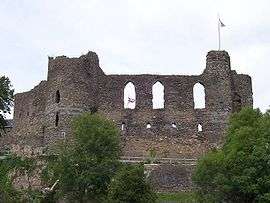Haverfordwest
Haverfordwest (/ˌhævərfərdˈwɛst/; Welsh: Hwlffordd [ˈhʊlfɔrð]) is the county town of Pembrokeshire, Wales, and the most populous urban area in Pembrokeshire with a population of 13,367 in 2001,[3] though its community boundaries made it the second-most populous settlement in the county, with 10,812 people.[4] The suburbs include the former parish of Prendergast,[5] Albert Town and the residential and industrial areas of Withybush (housing, retail parks, hospital, airport and showground).
Haverfordwest
| |
|---|---|
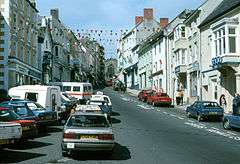 | |
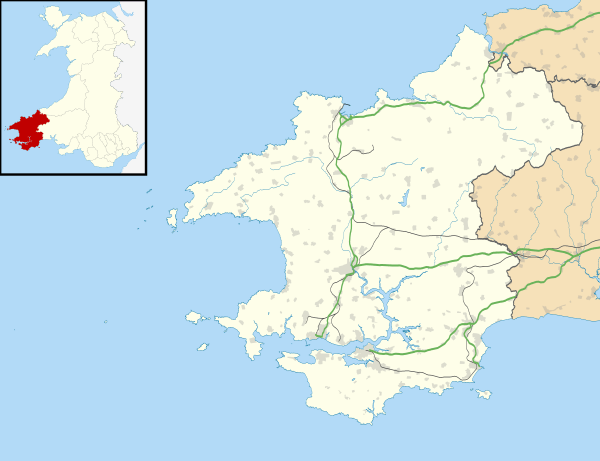 Haverfordwest Location within Pembrokeshire | |
| Population | 12,042 (parish 2011)[1] |
| OS grid reference | SM955155 |
| Community |
|
| Principal area | |
| Ceremonial county | |
| Country | Wales |
| Sovereign state | United Kingdom |
| Post town | HAVERFORDWEST |
| Postcode district | SA61, SA62 |
| Dialling code | 01437 |
| Police | Dyfed-Powys |
| Fire | Mid and West Wales |
| Ambulance | Welsh |
| UK Parliament | |
| Senedd Cymru – Welsh Parliament |
|
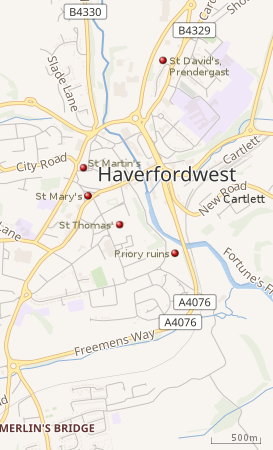 |
| The town centre, showing parish churches |
Haverfordwest is located in a strategic position, being at the lowest crossing point of the Western Cleddau prior to the opening of the Cleddau Bridge in 1975.
Topography
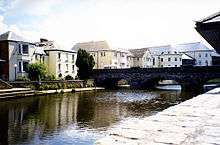

Henry G Gastineau, 1830
Haverfordwest is a market town, the county town of Pembrokeshire and an important road network hub between Milford Haven, Pembroke Dock, Fishguard and St David's as a result of its position at the tidal limit of the Western Cleddau. The majority of the town, comprising the old parishes of St. Mary, St. Martin and St. Thomas, lies on the right (west) bank of the river. On the left bank are the suburbs of Prendergast and Cartlett. At this point, a pair of sandstone ridges extending east-west and separated by a deep, narrow valley, are cut through by the Western Cleddau. This leaves two high spurs on the west side of the river. On the northern spur, the castle and its surrounding settlement form the core of St Martin's parish. On the southern spur, the High Street ascends steeply from the river and forms the core of St Mary's parish. From the foot of each spur, ancient bridges cross the river to Prendergast: St Martin's Bridge ("the Old Bridge") and St Mary's Bridge ("the New Bridge", built in 1835). St Thomas's parish occupies the south side of the southern spur. From these core areas, the town has spread, mainly along the ridges. In addition to the four ancient parish churches, the remains of an Augustinian priory are visible at the southern edge of the town.
Toponymy
The name of the town means "ford used by heifers"[6] or "ford used by goats" from Old English hæfer. In local dialect, it is pronounced "Harford". "West" was added in the 15th century, to distinguish the town from Hereford.[7] The Welsh name is said by B. G. Charles to be "merely a corruption of the English name".
History
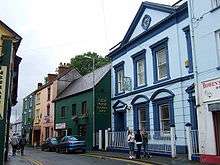
Haverfordwest has been English-speaking for centuries. South Pembrokeshire is known as 'Little England Beyond Wales', but because the markets traded with Welsh farmers in the north and east, there has always been a significant Welsh-speaking influence. The suburb of Prendergast seems to have originated as an extramural Welsh dormitory, dating from the times when all agricultural trade had to pass through the borough, and the fearful Normans before the destruction of Anglo-Norman power in 1136 tried to prevent Welshmen bearing arms from entering within the castle walls after nightfall.
Origins
It seems likely that such an obvious strategic location would have been settled in some way from an early date.
The scores of Iron Age and Roman coinage and artefact discoveries, and excavations by the Dyfed Archaeological Trust under the direction of Heather James at Carmarthen (Moridunum) in the 1980s, point to significant Roman penetration to this westernmost part of Wales. The strategic position of Haverfordwest with its defensive bluff overlooking the lowest fordable point on the western Cleddau and accessible to sea traffic would have required a Roman presence, probably modest in scale, from the 1st century AD to protect supplies to and from the coast, e.g. the Roman legionary headquarters at Caerleon were roofed with slates from the lower slopes of the Preseli Hills. In 1992 aerial photography identified a Roman road running west of Carmarthen past Wiston to Poyston Cross, raising the possibility of Roman fortlets at strategic river crossings at Whitland and Haverfordwest. Edward Llwyd's note to Camden's Britannia (ed. 1695) refers to a valuable find of silver coins at Llanboidy, the latest coin being one of Domitian struck in AD 91. In the 1920s Sir Mortimer Wheeler partially excavated a Roman dwelling or villa at Wolfscastle; work was restarted in 2002 by Professor Merroney. James Phillips, in The History of Pembrokeshire (published 1909), records a find of Roman silver coins in Haverfordwest, the earliest dated coin a Valerian and the latest a Claudius Gothicus. The museum in which the coins were deposited has been "scattered to the winds" and the whereabouts of the coins is unknown.
Phillips claimed that the pre-Norman name of Haverfordwest was Caer Alun, so named by the Emperor Maximus (Macsim Gwledig). His sources are not given but the Cambro-Briton in 1822 also recorded that Maximus, the last Roman Emperor of Britain, a man who for a time divided the Roman Empire with Theodosius I, on withdrawing Roman legions from Britain granted civic status and Celtic names to a number of pacified Romano-British settlements, including Southampton, Chichester, Old Sarum near Salisbury, Carmarthen (Caerfyrddin) and Haverfordwest (Caer Alun). Maximus had married Elen, a Welsh noblewoman, and they had three sons. Phillips claims that the name actually given to the town was Caer Elen, in honour of his wife (the name later changing to Caer Alun).
Medieval period
The ecclesiastical centre of the area (perhaps the seat of a bishop in the Age of the Saints) was probably one of the several churches of the local St Ismael, most probably St. Ishmael's.[8] This occurred around 1110.[9]
The proposition that Haverfordwest Castle was founded by Tancred, a Flemish Marcher Lord,[10] is questionable. The Marcher Lords were not Flemish but Norman Barons originally along the Marches (Anglo-Welsh border). The castle is recorded as having been founded in 1100 by the Norman Gilbert de Clare. The Flemings, said to have arrived in three groups in 1107, 1111 and 1151, are likely to have participated in its later development for their own and the Normans' protection from the Welsh warlords. It is recorded that the Constable of the castle in 1207 was Itohert, son of Richard Tancard, possibly a descendant of the first Tancred.
The Flemish presence, reputed to result from floods in the Low Countries, was more likely to have consisted initially of Flemish mercenaries originally in the invading army of William the Conqueror, who in reward for their part in William's victory were granted lands in parts of Northern Britain, and in Wales in the Gower, and Geraldus Cambrensis recorded their presence in the Hundred of Roose in Pembrokeshire.
A Fleming, Wizo, who died in 1130 founded at Wiston a motte and bailey fortification, the forerunner of the stone castle, for protection against the Welsh warlords: the Flemings were reportedly unpopular wherever they settled. The precarious position of Normans and Flemings was demonstrated in 1136 when the Normans, having already lost 500 men in battle at Loughor, re-recruited from Lordships from all over South Wales and led by Robert fitz Martin at Crug Mawr near Cardigan attacked Owain Gwynedd and his army. Routed, they fled over the Teifi Bridge which collapsed; the retreating Normans drowning under the weight of their armour. Their leader Richard de Clare had previously been intercepted and killed by Iorwerth ab Owen. Wiston and the castle were overrun in 1147 by Hywel Sais, son of Lord Rhys. Ranulf Higden in his Polychronicus records the Flemings as extinct in Pembrokeshire by 1327 but Flemish mercenaries reappear in 1400 when at the behest of Henry IV they joined an army of 1,500 English settlers who marched north from Pembrokeshire to attack the army of Owain Glyndŵr at Mynydd Hyddgen. The attack was repulsed with heavy casualties and legend has it that English prisoners were spared but surviving Flemish mercenaries were massacred or sold into slavery.
St Mary's Church originated at the end of the 12th century and the current (Grade I listed) building was constructed between the 13th and 15th centuries[11] and prominently visible at the top of the High Street.
Haverfordwest rapidly grew, initially around the castle and St Martin's Church (the settlement being called Castletown), then spreading into the High Street area. It immediately became the capital of the hundred of Roose (part of Little England beyond Wales), and because of its pivotal position, the commercial centre of western Dyfed, which it has remained to this day. In common with other British towns, its growth was rapid during the period up to 1300, and its extent[12] by then was much the same as it was in the early 19th century. A large town by the standards of the time, its population was probably around 4,000–5,000. It received its first marcher charter from William Marshall, 1st Earl of Pembroke sometime between 1213 and 1219, and obtained the lucrative trading privileges of an English borough. It traded both by land and sea and had a busy tidal quay on the river below the "New" Bridge. At least ten guilds operated, and there was significant woollen cloth manufacture. On 30 April 1479, the town was designated a county corporate by a charter of Edward, Prince of Wales, with the aim of supporting a campaign against piracy in local waters. It shared this distinction only with Carmarthen and a few towns in England and remained officially "The Town and County of Haverfordwest" until the abolition of the borough in 1974.
In common with other large towns in Europe, Haverfordwest was hit hard by the Black Death in 1348, suffering both depopulation (perhaps by more than 50%) and diminution of trade. Large parts of the town were abandoned, and it did not start to recover until the Tudor period. At the end of the 17th century,[13] the town was still significantly smaller than in 1300. In 1405, the town was burned by the French allies of Owain Glyndwr, although in its early history Haverfordwest suffered less than most towns in Wales from such depredations.
Post-medieval
During the English Civil War, the burgesses of the borough supported Parliament, while the ruling gentry were Royalist. As a result, there was considerable conflict, and the town changed hands five times.[14] There followed a period of stagnation in which the comparative status of the town declined. Haverfordwest today has the air of a typical small country market town, but the centre still conveys the feel of the important mediaeval borough. The once run-down riverside area has been renovated and Bridge Street has been pedestrianised and improved.
Haverfordwest was bombed for the first time during the Second World War on 24 September 1940. The City Road and New Road areas were hit, although there had been little preparation and no warning siren sounded. There were no casualties.[15]
Haverford Township, Haverford and Havertown in Pennsylvania, United States, are all named after Haverfordwest.
Governance
For local government purposes the community of Haverfordwest comprises five wards: Castle, Prendergast, Portfield, Priory and Garth. The community has its own town council and mayor.[16]
Pembrokeshire County Council conducted an extensive review of community boundaries in 2007[17] which made a number of submissions to the boundary commission for Wales. These submissions included a number of recommendations for the extension of the Haverfordwest community boundary where there had been perceived community overspill due to housing developments. These suggestions were mostly implemented,[18] with one significant exception[19] leading to an increase in the number of electors in the Haverfordwest community. One area of contention concerned the status of the village of Merlin's Bridge which continues to have its own community council despite its close proximity to Haverfordwest and a degree of community over-spill.[20] As such the conurbation of Haverfordwest and Merlin's Bridge is the most populous urban area in Pembrokeshire though Haverfordwest's community boundaries mean it is only the second most populous settlement in the county after Milford Haven.[4]
Haverfordwest is part of the Preseli Pembrokeshire National Assembly for Wales constituency and UK Parliamentary constituency. The local Assembly Member is Paul Davies of the Conservative Party[21] and the local Member of Parliament is Stephen Crabb[22] also a Conservative.
Haverfordwest is twinned with Oberkirch, Germany.
Demography
The 2011 census quoted a population of only 12,042 living within the confines of the parish. This agreed with the total population of all five wards involved: Castle, Prendergast, Portfield, Priory and Garth. Merlin's Bridge is a contiguous village and community situated to the south.[23]
Economy
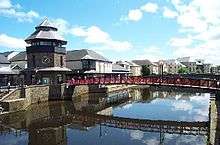
In accordance with its status as a sub-regional hub-town, Haverfordwest continues to serve as Pembrokeshire's principal commercial and retail centre.[24] The development of the riverside shopping centre in Withybush on the outskirts of the town includes Marks & Spencer in 2010[25] and Debenham's in 2013.[26]
A new town library opened in 2018 in the former Riverside Market building.
Concerns about the relative decline of the historic town centre compared to the growth of the retail centre at Withybush led to Welsh historian John Davies expressing his concern that Haverfordwest is becoming "a medieval town surrounded by tin sheds".
Education
- Haverfordwest Grammar School, 1488–1978, was for a period in the 20th century one of only two public schools in Wales.
- Haverfordwest High VC School, an English-medium secondary school, was formed in 2018 by the merger of Sir Thomas Picton School and Tasker Milward School.[27]
- Pembrokeshire College, an affiliated college of the University of Glamorgan, is situated in the Merlin's Bridge suburb of the town. The college serves as the principal centre of further and higher education in Pembrokeshire.
- Ysgol Caer Elen, a Welsh-medium school for pupils aged 3 to 16, opened in 2018, replacing Ysgol Gymraeg Glan Cleddau. The new school cost £28 million to build and has the capacity for 315 primary and 600 secondary pupils. The nursery has the capacity for 45 children.[28]
- Redhill Preparatory School is an independent school established in 2001 which includes a Montessori learning component for younger pupils.[29]
- Waldo Williams Primary School opened in 2019, combining the former Mt Airey and Haverfordwest Church in Wales VC schools. It is named after the poet Waldo Williams (1904–1971).[30]
Sport and leisure
Haverfordwest County play association football in the Cymru Premier (the top tier of Welsh football) at Bridge Meadow Stadium, while Merlins Bridge play in the local Pembrokeshire League. Haverfordwest RFC, which formed in 1885, play rugby union at their Pembroke Road ground, and Haverfordwest Cricket Club play at Dale Road.
In 2009, Haverfordwest's sports and leisure provision benefited from significant investment, with the opening of a new £8 million leisure centre situated at St. Thomas Green.[31]
The kayaking club venture to sea as well as using the rivers.[32]
Haverfordwest High VC School benefits from a wide range of sporting facilities, including a purpose-built sports centre with a hockey pitch, artificial turf and a full-sized athletics track.
Health
Withybush General Hospital is one of the main hospitals of West Wales and part of the Hywel Dda University Health Board, formerly Pembrokeshire & Derwen NHS Trust. The hospital has most services, but paediatric and maternity services have been moved to Glangwili General Hospital, Carmarthen.[33]
Transport
Haverfordwest is served by Haverfordwest Airport.
Haverfordwest railway station is on the West Wales Line. It is served by Transport for Wales services to Manchester Piccadilly and Milford Haven.
Haverfordwest bus station is located beside Riverside Quay Shopping Centre. It has six bus stops with two additional bays for coach drop off/pickup.[34] It is served by Edwards Coaches, First Cymru, National Express and Richards Brothers.
Forming one of the major "road hubs" of West Wales, the town is at the junction of the A40, A4076 and A487 roads and several rural B roads, including the B4329 running northwards to Eglwyswrw across the Preseli Mountains. The A40 connects Haverfordwest with Carmarthen to the east and Fishguard to the north; the A4076 connects Haverfordwest with Milford Haven and Pembroke Dock to the south; the A487 connects Haverfordwest with St Davids to the northwest.
Notable people
- See Category:People from Haverfordwest
- Henry Baird, cricketer and British Army officer; recipient of the Distinguished Service Order for actions in the Second Boer War.
- Christian Bale, actor who played the protagonist in Empire of the Sun and Batman in Christopher Nolan's The Dark Knight Trilogy, was born in Haverfordwest in 1974.
- Captain Francis Cromie, Royal Navy commander and the first member of the British military to lose his life in Russia after the revolution, attended Haverfordwest Grammar School. A house at the Grammar School was subsequently named after him, as was a street in the town.
- Geraint Wyn Davies, a Welsh-Canadian actor, spent his early life in the town, where his father was the Congregational Church minister.
- Simon Davies, a footballer who has played for Fulham and Wales, was born in Haverfordwest.
- Mark Delaney, a footballer who played for Cardiff City, Aston Villa and Wales, was born in Haverfordwest.
- Connie Fisher, actress and singer, the winner of the BBC talent show How Do You Solve a Problem Like Maria?, lived in Haverfordwest from the age of six.
- June and Jennifer Gibbons, the selective mute twins, whose story gained international interest after Marjorie Wallace documented their story, lived in Haverfordwest for much of their childhood.
- Simon Halliday, an England rugby union international, was born in Haverfordwest.
- Terry Higgins, among the first people known to die of an AIDS-related illness in the UK, lived in Haverfordwest as a child. The Terrence Higgins Trust is named after him.[35]
- Rhys Ifans, actor, starred in the 1997 black comedy Twin Town and played Hugh Grant's delusional flatmate in Notting Hill, was born in Haverfordwest in 1967.
- Elis James, stand-up comedian and actor, was born in Haverfordwest in 1980, though he grew up in Carmarthen, which he calls his hometown.
- Sir William James, 1st Baronet, born in Haverfordwest. Eighteenth-century naval officer.
- Gwen John, artist, was born in Haverfordwest; her younger brother Augustus John, also an artist, was born in nearby Tenby and lived in Haverfordwest for a time.
- Chelsea Manning, American activist and whistleblower, lived in Haverfordwest as a child.[36]
- Peter Morgan, a councillor, mayor and rugby player (Llanelli, Wales and British Lions) born locally and went to school in Haverfordwest.
- Sir John Perrot, said to be an illegitimate son of Henry VIII, was born in Haverfordwest.[37]
- Fiona Phillips, television presenter, lived in Haverfordwest from the age of 18.
- Greg Pickersgill, an influential science fiction fan, was born in Haverfordwest in 1951 and lives there today.
- The hardcore punk rock band Picture Frame Seduction was formed in the Sir Thomas Picton School in 1978.[38]
- Sir Thomas Picton, a British army general, was born in Haverfordwest and killed at the Battle of Waterloo.
- Gruff Rhys, the singer of indie rock band Super Furry Animals, was born here.
- John Lort Stokes was an officer in the Royal Navy who travelled on HMS Beagle.
- Graham McPherson, aka Suggs, lead singer of Madness, attended Haverfordwest Grammar School for Boys in the early 1970s.
- Lucy Walter, a mistress of Charles II, was born at Roch Castle near Haverfordwest.
- Waldo Williams, Welsh language poet and pacifist, was born in Haverfordwest.
Freedom of the Town
People and military units that have honoured with the Freedom of the Town of Haverfordwest include:
Individuals
- Vice Admiral Rt Hon Lord Nelson KB: 1802[39][40]
- Admiral Sir Thomas Foley GCB: 1802[39][40]
Bibliography
- Humphrey Holdfast, Haverfordwest And Its Story, Llewellyn Brigstocke, Publisher, 7 Market Street, Haverfordwest, 1882 (published by subscription).
- Dillwyn Miles (ed) A History of Haverfordwest, Gomer, 1999, ISBN 1-85902-738-5
References
- "Haverfordwest parish population 2011". Archived from the original on 18 April 2015. Retrieved 18 April 2015.
- https://haverfordwesttown.co.uk/
- Archived August 20, 2011, at the Wayback Machine
- "2001 Settlement Populations". Archived from the original on 3 March 2016. Retrieved 10 September 2013.
- "GENUKI: Prendergast". Archived from the original on 24 September 2015. Retrieved 8 April 2015.
- Charles, B. G, The Placenames of Pembrokeshire, National Library of Wales, Aberystwyth, 1992, ISBN 0-907158-58-7, Vol II, p 643
- Mills, A. D. (2003). Dictionary of British Place Names. Oxford University Press. p. 232. ISBN 978-0199609086.
- Williams, A. H. (1941). An Introduction to the History of Wales: Volume I: Prehistoric Times to 1063. Cardiff: University of Wales Press. p. 120.
- Miles p 12
- Muller, Mark (2011). "900 year celebrations for Haverfordwest". Pembrokeshire: the journal of the Pembrokeshire Historical Society. 20: 53–60.
- Cadw. "St Mary's Church (Grade I) (12226)". National Historic Assets of Wales. Retrieved 25 July 2019.
- Miles p 28
- Miles p 23
- Miles, p 177
- Richards, Bill, Pembrokeshire Under Fire: The Story Of The Air Raids OF 1940–1, Paterchurch Publications, 1995. ISBN 1-870745-05-1
- "Haverfordwest | Haverfordwest Tourism and Travel | Town Council | Community | Sport and Leisure | Holiday in Haverfordwest, Pembrokeshire South West Wales". Haverfordwesttown.co.uk. Archived from the original on 28 October 2013. Retrieved 10 September 2013.
- "Community Council Boundary Review - Pembrokeshire County Council". Pembrokeshire.gov.uk. Archived from the original on 12 January 2015. Retrieved 10 September 2013.
- "Comisiwn Ffiniau a Democratiaeth Leol Cymru - Local Democracy and Boundary Commission for Wales" (PDF). Archived from the original (PDF) on 15 June 2011.
- "Uzmaston community will not be merged with Haverfordwest (From Western Telegraph)". Westerntelegraph.co.uk. 17 September 2010. Archived from the original on 12 January 2015. Retrieved 10 September 2013.
- "Archived copy". Archived from the original on 29 September 2011. Retrieved 23 December 2010.CS1 maint: archived copy as title (link)
- "National Assembly for Wales | Paul Davies". Assemblywales.org. Archived from the original on 12 February 2012. Retrieved 10 September 2013.
- "The Conservative Party | People | Members of Parliament | Stephen Crabb MP". Conservatives.com. Archived from the original on 3 October 2013. Retrieved 10 September 2013.
- Merlins Bridge Community Council Archived 2015-04-17 at the Wayback Machine, Pembrokeshire Town & Community Councils
- "Excited crowds gather for M&S opening (From Western Telegraph)". Westerntelegraph.co.uk. 11 November 2010. Archived from the original on 5 October 2013. Retrieved 10 September 2013.
- "Debenhams opening in Haverfordwest sparks road chaos fears". Western Telegraph. 26 September 2013. Archived from the original on 12 January 2015. Retrieved 5 December 2014.
- Wightwick, Abbie (28 January 2019). "Nearly 200 schools have shut in Wales since 2013". Wales Online. Retrieved 1 February 2019.
- "New £28m Welsh-medium school in Haverfordwest opens". BBC News. 6 September 2018. Retrieved 6 September 2018.
- "Redhill invests £1m for the future". Western Telegraph. 23 July 2014. Archived from the original on 15 March 2018. Retrieved 14 March 2018.
- David Lynch (13 November 2018). "New Haverfordwest school to be named after Waldo Williams". Western Telegraph. Retrieved 15 February 2019.
- "Haverfordwest Leisure opens its doors". Leisureopportunities.co.uk. 27 February 2009. Archived from the original on 3 March 2009. Retrieved 10 September 2013.
- "Archived copy". Archived from the original on 27 February 2015. Retrieved 27 February 2015.CS1 maint: archived copy as title (link)
- "October 20 date set for removal of 24hr paediatrics from Withybush Hospital". Western Telegraph. 20 August 2014. Retrieved 30 January 2020.
- "Pembrokeshire County Council - New Bus Station to Open on Time". Pembrokeshire.gov.uk. Archived from the original on 29 September 2011. Retrieved 10 September 2013.
- "BBC News - Terrence Higgins' legacy, 30 years after death". BBC News. Archived from the original on 2 December 2017.
- Thompson, Gareth (8 August 2010). "Early Struggles of Soldier Charged in Leak Case". New York Times. Archived from the original on 6 September 2012. Retrieved 20 August 2018.
- Turvey, Roger (2004). "Perrot, Sir John (1528–1592)". Oxford Dictionary of National Biography (online ed.). Oxford University Press. doi:10.1093/ref:odnb/21986. (Subscription or UK public library membership required.)
- Parry, Nick (5 August 2008). "Punk band mark 30th anniversary". BBC News. Retrieved 13 January 2020.
- "Town finds lost Nelson scroll - in its safe". Wales Online. 31 March 2013. Retrieved 28 March 2020.
- "House where Nelson given Haverfordwest honour for sale". BBC News. 22 June 2010. Retrieved 28 March 2020.
- "Soldiers given freedom of Haverfordwest". Western Telegraph. 4 March 2009.
